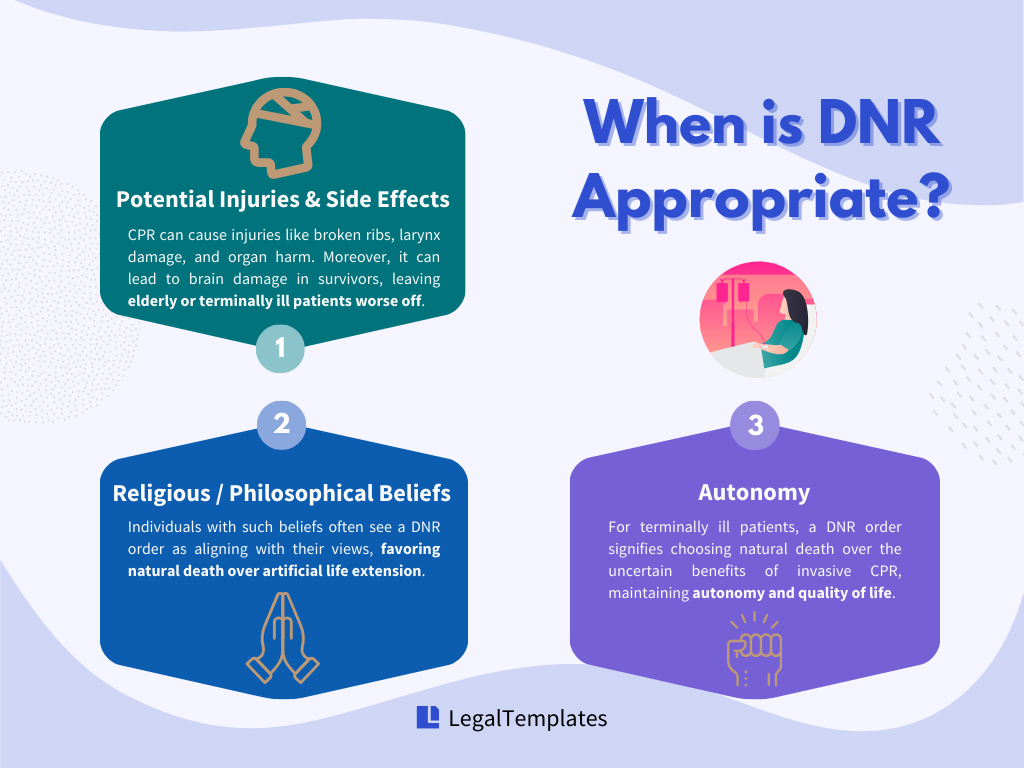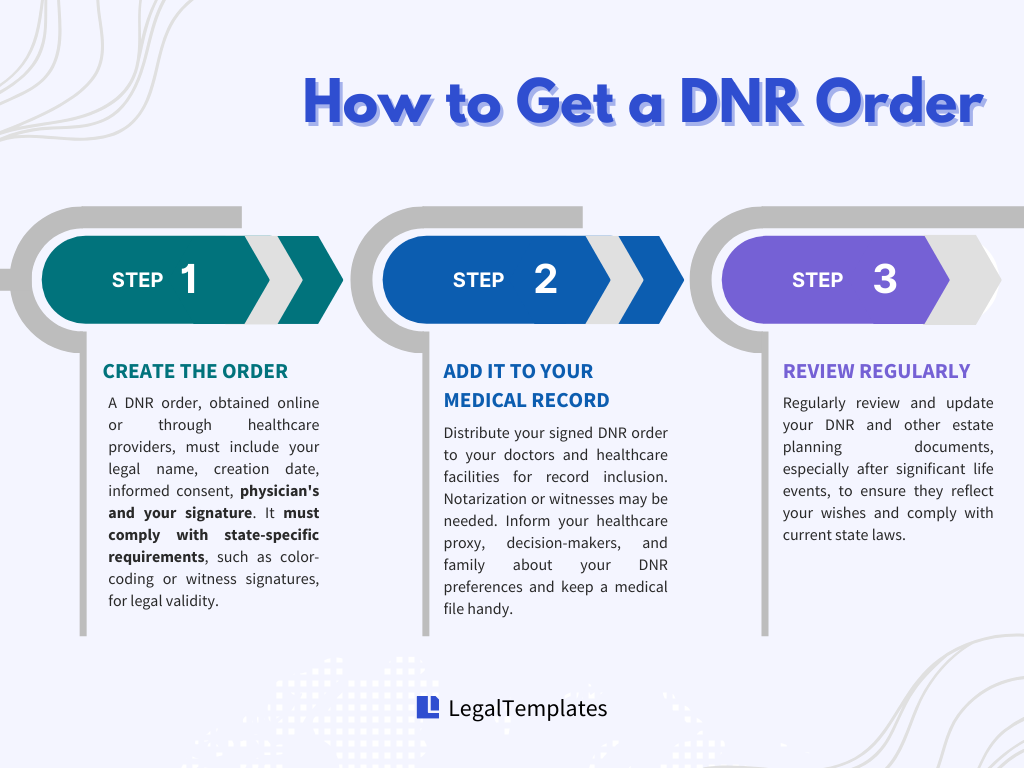
How do you want your doctor or first responders to proceed if you stop breathing? For those facing this crucial question, a Do-Not-Resuscitate (DNR) order is an essential legal directive that informs healthcare professionals of your preferences in life-threatening situations.
This article provides a comprehensive understanding of DNRs. We will examine the legal framework to help you navigate the complexities of DNR orders; in addition, we’ve also invited Content Administrator Karina Jugo for a short interview to share her insights on having family members with DNRs, adding depth to our exploration.
What Is a DNR Order?
A Do-Not-Resuscitate (DNR) order is a medical order that instructs health care providers not to perform cardiopulmonary resuscitation (CPR) if a person’s heart breathing stops (or, in medical terms, when the patient experiences cardiac or respiratory arrest).
Medical professionals are required to perform CPR to restart your heart and save your life — unless a DNR order has been issued. If you sign a DNR order, it means you don’t want doctors or emergency personnel to perform CPR to save your life when you stop breathing or your heart stops beating.
DNR orders are commonly included in advance directives, a set of legal documents that addresses your wishes and preferences for health care.
Is a living will the same as a DNR?
A living will is not the same as a DNR. A living will expresses your wishes regarding life-sustaining treatment in end-of-life situations, while a DNR specifically instructs healthcare providers not to perform CPR if your heart or breathing stops.
What Is CPR?
CPR, or cardiopulmonary resuscitation, refers to the resuscitation of the heart via chest compressions and artificial ventilation on individuals with cardiac arrest.
Basic CPR techniques involve a series of aggressive chest compressions and mouth-to-mouth breathing to stimulate the heart and promote regular breathing. Medical professionals may carry out more advanced resuscitative procedures, including the use of a defibrillator or intubation.
Although it might seem like allowing resuscitation is always the best choice, it might not be the most favorable choice under some circumstances.
When Is DNR Appropriate?
While there is no correct answer to this question, a DNR order may be considered appropriate or even necessary under these circumstances:

1. You Don’t Want Any Side Effects
Medical experts routinely state that timely CPR by paramedics or in hospitals has saved many lives. However, around 50% of patients with chronic diseases who survived CPR wished they hadn’t received it.
This is because CPR — even if successful — can lead to painful physical injuries, such as cracked or broken ribs, fractures of the larynx (voice box), or even damage to internal organs.
Moreover, many CPR survivors suffer brain injury or other neurologic disability due to the procedure, as irreversible damage can occur to the brain during the process of resuscitation due to lack of oxygen.
All in all, a frail and elderly patient may be left worse after CPR than before. Therefore, patients with terminal illnesses or other end-of-life medical conditions often stipulate that no CPR be performed in their medical directives or living wills.
Do-Not-Intubate
Some hospitals and medical institutions treat a “Do-Not-Intubate” (DNI) order as a separate medical directive distinct from a Do-Not-Resuscitate (DNR) order. Confer with your healthcare providers to see how they treat these two orders to ensure your preferences are being addressed clearly.
2. Your Beliefs Align With It
Content Administrator Karina Jugo shares her personal experience with us regarding her loved ones having DNRs in place because of their beliefs.
“We come from a strong Catholic background,” she said, “And we believe our earthly existence is just a journey to eternity.”
Like Karina’s family members, many individuals who hold religious or philosophical beliefs find that the DNR order aligns with their perspectives in allowing a natural progression towards death without artificial prolongation of life.
Any medical directive should begin with a profound analysis of your thoughts and beliefs on the subject of life and its end, and you may wish to seek counseling from your faith leaders if you have questions.
What if the family disagrees with the DNR order?
Healthcare providers typically honor the patient’s expressed wishes even if the family disagrees with a DNR order. Clear communication and documented directives are key to ensuring that a patient’s choices are respected amidst family disputes.
3. You Want More Control
A 2022 study found that 40% of terminal cancer patients signed their first DNR order within their last week of life, demonstrating an intent of decision-making for end-of-life care towards the late stage of their lives.
For terminally ill patients, a DNR order represents a significant choice to accept the potential outcome of natural death. The invasive nature of CPR may not add meaningful days to life and could potentially compromise the quality of the time that remains.
Such a decision is often rooted in the desire for autonomy, allowing patients to exercise control over their healthcare and end-of-life experience.
If you are terminally ill, it would be best to talk to your doctor about the different resuscitation options available for patients with your medical condition. Talk about the benefits and risks of CPR, defibrillation, or intubation and the success rate of each. Ask not only how these treatments affect patients but also how they affect patients with your specific condition.
Once fully informed on your particular medical situation, you can begin to prepare any health care directives or orders you wish.
What if I am unable to make a decision?
If you’re unable to decide on resuscitation, a legally appointed health care proxy or advance directive can specify your wishes for you. If there’s no advance directive, decisions about resuscitation may fall to your closest family members or legal next-of-kin.
How to Get a DNR Order
If you decide to get a DNR order for yourself, follow the steps below to ensure your DNR is recognized and legally valid.
Restrictions
Individuals who lack mental capabilities or under 18 cannot create DNR orders for themselves.

Step 1: Create the Order
A DNR order can be obtained from an online builder, your state’s Department of Health, or your physician or medical facility. You will need your physician to complete the DNR order with you. Key elements of the order include:
- Your full legal name;
- Creation date;
- A physician’s statement stating that 1) you have been fully informed of the nature and consequences of the DNR order and 2) you have the capacity to make this medical decision;
- Physician’s signature;
- A patient’s statement stating that you understand the implications of the DNR order and voluntarily agree to it;
- Your signature.
If any of the above element is missing from your order, it may not be legally valid depending on your state requirements. Some states also require the DNR to be printed on brightly-colored paper so it’s not overlooked by medical personnel. For example, Florida requires the DNR order to be on yellow paper only.
In addition, every state’s DNR laws may have different or additional requirements, so make sure you understand your state’s specific requirements and consult with an attorney if necessary. Some states require you to use a standardized form only. Some states require witnesses to sign the order as well.
Your physician can only sign your DNR order after consulting with you and explaining to you the implications of the DNR order.
Step 2: Add It to Your Medical Record
You should give copies of the completed and signed DNR order to your primary doctor, other medical specialists, and any medical institution where you receive care so that the DNR order can be added to your medical records.
Consider having a notary or witnesses for the DNR order for extra security, as it’s a requirement in some states. Also, some physicians may not honor a DNR that hasn’t been notarized or witnessed.
In addition, it’s crucial to inform your healthcare proxy, agent, and any other individuals you have empowered to make decisions about your plans and wishes.
Finally, it would be best to inform your family of your decision and where to access your DNR order.
Keeping a medical file close to you can be helpful. For instance, after Content Administrator Karina Jugo’s family decided to have thir DNR in place, they stored the DNR on the last page of their medical file folder for elderly patients who make frequent trips to the hospital.
“It’s usually a clear book folder that holds all diagnoses and test results in chronological order, so doctors or emergency room personnel won’t need to conduct the time-consuming patient interviews upon admission.” She explains.
Step 3: Review Regularly
Review your DNR order, advance care directive or living will, and your medical power of attorney to ensure that the estate planning documents reflect your wishes. Certain life events may necessitate the need to amend these documents.
In addition, make sure your estate planning documents (including your DNR order) comply with any changes in your state’s laws.
► READ MORE: 9 End-of-Life Documents Everyone Needs
What if I changed my mind after a DNR order is written?
If you change your mind, communicate that fact to your doctor. The doctor must remove the DNR order from your medical record and file. The best practice is to retrieve the document and physically destroy it.
How Do Paramedics Know If You Have a DNR?
In some states, the DNR order is only recognized at the hospital and does not apply in out-of-hospital settings. This means that medical personnel responding to an emergency may still administer CPR outside of a hospital.
Therefore, it is crucial to know the DNR laws in your state. For instance, a DNR order is honored in most health care settings in Florida, including hospices, adult family care homes, assisted living facilities, nursing homes, and so on. This also includes emergency medical technicians or paramedics in settings other than a healthcare facility when presented with a DNR order.
Conversely, in states where DNR orders are only recognized at hospitals and you wish to not be resuscitated outside of a hospital, you can ask your physician to complete an out-of-hospital DNR order.
When you have an out-of-hospital DNR order, you will be instructed on how to communicate this directive to first responders effectively. This may involve wearing a specially designated bracelet or necklace or displaying the DNR documentation in a prominent place, such as on the refrigerator or within immediate view in the home.
Paramedics, upon responding to a call, will look for an out-of-hospital DNR order, ensuring it has the required original signatures. They may also check for a DNR bracelet or necklace. These indicators authorize emergency personnel to refrain from administering CPR.
Important Note
Only physician-ordered DNR bracelets or necklaces are valid for EMT (emergency medical technicians). For peace of mind and clarity in an emergency, consult your physician about state-approved DNR wearables.
It is important to note that the availability and recognition of out-of-hospital DNRs can vary by region and emergency medical service. Check your local laws and regulations and consult with your healthcare provider to ensure that your DNR preferences are clearly communicated and legally compliant.
Personal Experience with DNRs: Karina Jugo’s Story
Content Administrator Karina shares more of her experience with DNR orders for her loved ones.
“Initially, we had to discuss how to respond to possible scenarios once a DNR is in place.” Karina states while reflecting on her experience when her loved ones first decided to have a DNR order. “It was only through these discussions that we learned that DNRs do not apply in out-of-hospital settings in our state.”
Moreover, there were fears and concerns surrounding the DNR. Discussions were necessary to address possible scenarios and determine the appropriate response.
“For instance, do you just sit and watch if the patient has a seizure prior to losing consciousness? Or do we call emergency personnel?” She says.
“Eventually, we were all made to understand that the DNR is made specifically for doctors and medical personnel who would be handling a patient in an end-of-life situation in a hospital and not for family members who are watching over their sick loved ones at home.”
The DNR played a crucial role in clarifying ambiguities about their loved ones’ wishes. It provided guidance on whether emergency personnel should administer first aid treatments and clarified preferences regarding invasive procedures and treatments like intubation.
“[Having a DNR in place] actually gave us relief and clarity knowing which direction to take when addressing end-of-life situations.” She says, “Maybe it’s primarily because our family members who had DNRs were already in their 80s, had lingering illnesses, or were already non-ambulatory or bedridden.”
Knowing the direction to take in end-of-life situations and fulfilling their loved ones’ wishes alleviated anxiety and uncertainty. Karina expresses that the DNRs provided them with peace of mind, knowing they were sparing their loved ones from prolonged suffering.
When asked what advice she would give to individuals considering a DNR for their family member, Karina states:
“If a family member is suffering from a terminal illness or has been bedridden with no possibility of regaining mobility, it would be kinder not to prolong their suffering with a DNR. A DNR does not mean you’ll stop treating someone who’s ill, so you can still provide pain management and palliative care.”
The experience with DNRs has shaped Karina’s views on end-of-life care and decisions.
“In addition to the suffering patient, the rest of the family also suffers emotionally, mentally, and financially. I think nobody wants to spend his final years hooked up to tubes and machines, so a DNR will spare the patient from all these (and their families) from dire financial straits.”
Respecting Last Wishes
Understanding the implications and requirements of a Do-Not-Resuscitate Order is crucial for respecting the autonomy and end-of-life wishes of individuals. Whether for yourself or a loved one, discussing and clearly documenting these preferences is essential to ensure that these critical decisions are honored in difficult times, providing peace of mind and dignity at life’s end.
